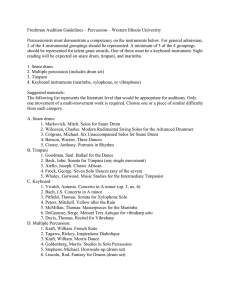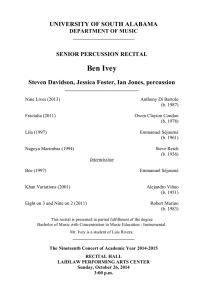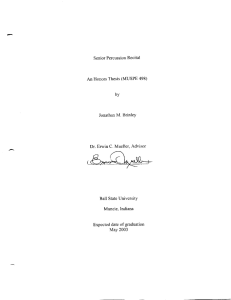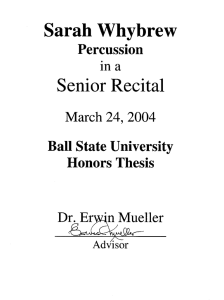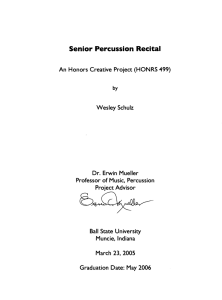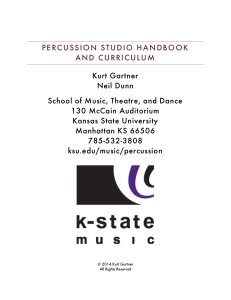Honors 499 A Senior Percussion Recital Daniel K. Porter Spring 2007
advertisement
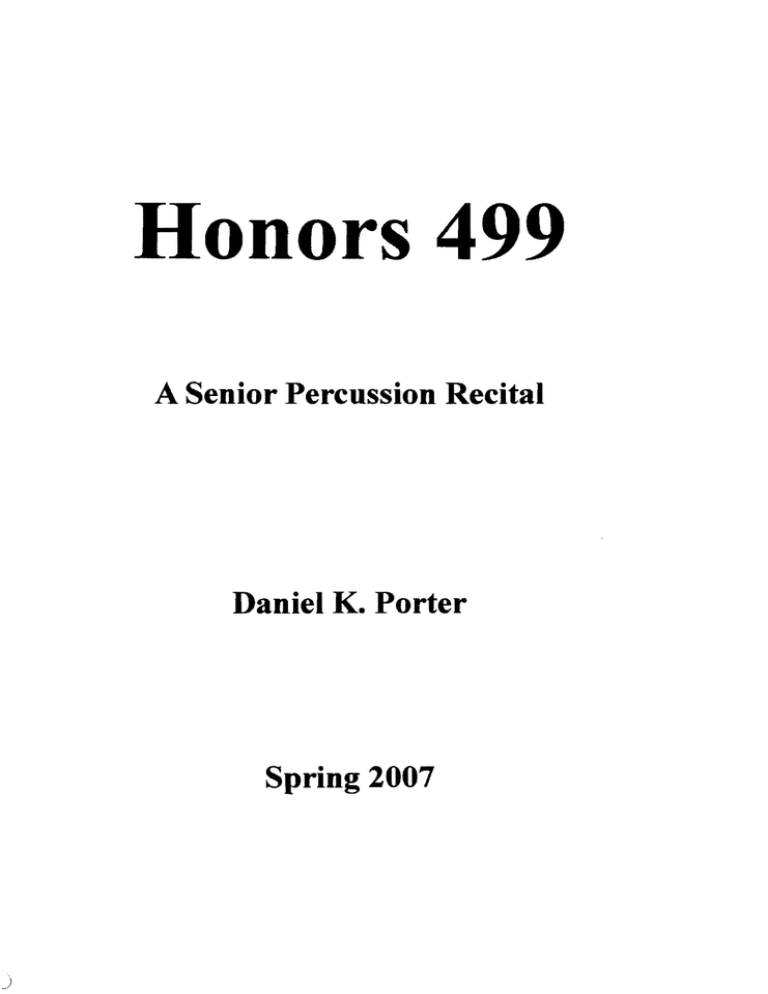
Honors 499 A Senior Percussion Recital Daniel K. Porter Spring 2007 SENIOR PERCUSSION RECITAL An Honors Thesis Project (HONRS 499) By Daniel K. Porter Dr. Erwin C. Mueller, Advisor Ball State University Muncie, IN Expected Graduation Date: December 2007 / ; , . DANIEL PORTER percussion SENIOR RECITAL assisted by Anna Vannesyan, piano Timothy Stephenson and Nichole Homer, percussion Vic Firth Suite for Four Timpani, Four Roto Toms and Drumset 1. II. III. Emmanuel Sejoume Losa Guy G. Gauthreaux II American Suite for Unaccompanied Snare Drum I. II. III. IY. arr. Terry Smith John Brown's Body Concerto #2 for Marimba and Orchestra I. Water Running in High Mountain II. Reflections and Dreams NeyRosauro Daniel Porter is a student of Erwin C. Mueller. He is the treasurer of the Ball State Audio Engineering Society and a member of the Society for Composers, Inc. This recital is presented in partial fulfillment of the requirements for the Honors Program at Ball State University. PRUIS HALL Friday, February 2,2007 5:30 p.m. Series LXI Number ~.----------------------------- Abstract: The aim of this Honors Thesis was to solidify four years of in depth study in the percussive arts by means of a solo performance recital. Planning for this recital began at the end of spring semester, 2006. My principal percussion instructor, Dr. Erwin C. Mueller approached me and simply asked, "Have you ever considered giving a recital?" At that point we perused the percussion library and selected possible pieces. Upon my return to campus in the fall of 2006, I met with Dr. Mueller, solidified the program for my recital, and immediately began preparing for its realization on February 2, 2007. During this entire semester, I studied privately with Dr. Mueller and practiced intensely. The secondary goal of this recital was audience appeal. The program I presented was carefully selected to provide a performance that would appeal to a wide variety of musical tastes within the audience. The first piece was a timpani and drum-set duet. It was an "attention-grabber" with its robust instrumentation and the contemporary musical genres represented within its three movements. The second piece on the program was another duet, but this piece utilized the rhythmic, harmonic, and melodic capabilities of the vibraphone and marimba in a Spanish Flamenco style. The third piece of the program was for solo snare drum and displayed a multiple of traditional and contemporary snare drum techniques while presenting four separate American snare drum styles. The fourth piece on the program was meant to appeal to those with an ear for jazz. For this portion of the recital, I played the lead part on vibraphone in a small jazz combo. The fifth and final piece was a concerto for a five-octave marimba and orchestra. It was somewhat challenging to convince a full orchestra to perform in my recital; consequently my marimba part was accompanied by a piano performing a reduction of the original orchestra parts. Program Notes: Suite for Four Timpani, Four Roto-Toms and Drum-Set First Movement This piece served as a wonderful opener for my recital. It kicks straight into a swing style and has colorful call and response between the timpani and drum-set. The timpani are treated like an upright bass for the swing portions of this movement. This created a very contemporary "drum and bass" groove that was very exciting. This first movement also contained very expressive cadenza sections. That is, sections where the timpani played virtuosic passages without drum-set accompaniment. This served to bring the soloist, myself, to the forefront and displayed the performance qualities of the timpani. Second Movement The second movement was composed in the style of a rock ballad. The timpani took on a harmonic roll and played chordal passages rather than strictly bass lines and melodies as in the first movement. These chords were achieved by using unique techniques on the timpani. For this movement I used three mallets at once rather than the traditional two to create three note chords. There were also significant pitch changes with regards to the timpani's tunings to accommodate the harmonic structure, as well as to create uninterrupted melodic material. Third Movement The third movement was an exciting finale in a disco rock style. It flowed seamlessly out of the second movement and carried through with flashy rhythms and speedy tempos until the end of the entire work. The piece as a whole concluded with an intense roto-tom solo and a large run up all the timpani and roto-toms that was punctuated by a supportive drum-set accompaniment. Basically, it made for a spectacular finish. About the Composer Vic Firth was the solo timpanist and principal percussionist for the Boston Symphony Orchestra. He has also held positions at the New England Conservatory of Music and the Berkshire Music Center at Tanglewood as the director of the Timpani and Percussion Departments. This single movement duet between marimba and vibraphone is reminiscent of the lively dance rhythms of Spanish Flamenco music. These syncopations present challenges to the performers, but when realized in performance contribute greatly to the overall character of the piece. Despite the syncopation, this piece remains incredibly lyrical with singable melodies that make it an easy piece for a very diverse audience to appreciate. About the Composer Emmanuel Sejourne is widely recognized as one of the world's leading mallet percussionists. He is currently a member of the Strasburg Conservatory and an active performer of hundreds of concertos, solos, and chamber works. In addition, he has given lectures in many universities in Europe, Japan, and North America and his personal compositions are recognized worldwide. American Suite: For Unaccompanied Snare Drum First Movement The first movement is used to introduce a short rhythmic motive that serves as the basis for the remainder of the work. This motive is constantly manipulated to accommodate multiple styles. In this particular movement, it is a cross between standard orchestral and contemporary techniques. This movement also calls on the performer to utilize hand to hand independence. Second Movement The second movement develops the primary motive in a marching/drum corps style: The technique calls for the performer to play with the traditional snare drum grip rather than the modern matched grip. Traditional grip requires a separate grip upon the drumsticks in each hand while matched grip uses the same in both hands. Third Movement The third movement is in jazz style and calls for wire brushes to be used rather than traditional drumsticks. The performer must use hand to hand independence to create a jazz feel while maintaining the pre-established rhythmic motive. Fourth Movement The fourth movement is in an exciting latin style. It uses mambo and salsa rhythms to embellish the motive. It also calls for complicated cross stick techniques as well as innovative snare manipulation on the snare drum mechanism itself. About the Composer Guy G. Gauthreaux II composed this piece in 1989 and it was selected as the 1st place winner in the 1989 Percussive Arts Society Composition contest by prominent percussionists Anthony Cirone, Mitchell Peters, and Garwood Whaley. John Brown's Body This piece is a transcription of an old time jazz standard solo. It is best performed in a combo setting with vibraphone as lead supported with piano accompaniment. In the context of my recital, a drumset part was added for additional variety and color. This piece is challenging to recreate because it was conceived as improvisation and then later transcribed. This leaves the performer with the freedom to interpret much of the phrasing and gestures. The goal is to capture the improvisational feel of this piece without compromising the written notes. About the Composer This piece was originally perfonned by Milt Jackson on vibraphone accompanied by the Oscar Peterson Trio. It was later transcribed from LP to sheet music by Terry Smith Concerto for Marimba and Orchestra, No.2 I. Water Running in High Mountain This movement and piece as a whole is designed to display the marimba as the principal instrument within the context of a symphonic orchestra. In this movement, the performer uses four mallets at once, two in each hand. The virtuosic attributes of this concerto call on the performer to utilize independence between each of the four mallets to produce four part harmony and complex rhythmic motives. II. Reflections and Dreams This movement also requires four mallets, but is not as rhythmically complex than the more modern first movement. This movement is much more expressive and reminiscent of older harmonic structures in the vein of some Bach or Beethoven. It is beautifully flowing and very lyrical. It was also my favorite selection within the whole program. It is for that reason that it was selected for the finale of this recital. About the Composer Ney Rosauro is recognized worldwide as one of the most innovative symphonic percussionists and composers today. He has taught in many universities and conservatories in his home country of Brazil and currently teaches percussion at the University of Miami, U.S.A. He has published over 30 pieces for percussion in addition to several method books and has appeared in concerts in over thirty countries. Acknowledgements: As a freshman Music Engineering student and an aspiring percussionist, if you had approached me and asked in would ever give a solo recital, I probably would have laughed. Although I was very interested in percussion and eager to learn more, the prospect of giving a solo recital seemed rather daunting and almost impossible. As a freshman, I entered the Ball State University Percussion Studio with a focus on drum-set, marching snare drum and tenor drums, and Rock n' Roll music. As far as I knew, that was all there was. I quickly learned that my percussion studies thus far had only scratched the surface of what the field really had to offer. Under the inspiring tutelage of Dr. Erwin C. Mueller, during the next four years I feel I earned a much greater understanding of what it means to call oneself a percussionist. My studies in Dr. Mueller's studio taught me the arts of marimba, vibraphone, xylophone, glockenspiel, chimes, timpani, solo snare drum, percussion and large ensemble experience, as well as exposure to the seemingly endless inventory of percussion instruments. Through the studio I was also exposed to many new styles of music, such as Jazz, Bebop, Latin, African, and Brazilian music. I also had the pleasure to perform with some truly amazing players such as Daniel McCloud, Timothy VanCleave, Nikki Homer, and many others. I am thankful for having the chance to study with such talented musicians, their proficiency as percussionists inspired me to better myself as a musician. I am forever indebted to Dr. Mueller for his infinite patience in teaching his craft to myself and countless other aspiring percussionists. His influence on my career as a musician has left an indelible mark.
